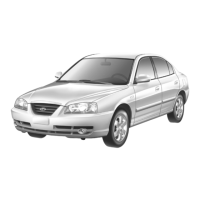Do you have a question about the Hyundai ELANTRA 2016 and is the answer not in the manual?
Details on how to operate the vehicle and its various functions.
Information on keeping the vehicle in good condition and performing regular maintenance.
Technical details and measurements for the vehicle.
Information from Hyundai Motor America regarding the manual and service.
Defines HYUNDAI Genuine Parts and their benefits for vehicle performance and reliability.
Highlights benefits and warranty coverage when using genuine HYUNDAI parts.
Provides guidance on identifying genuine HYUNDAI parts by their logo and packaging.
Guidance on reading the manual, understanding warnings, and navigating its sections.
Information on the types of fuel suitable for the vehicle and fuel additives.
Precautions to take during the initial period of vehicle use for optimal performance.
Identifies major external components of the front of the vehicle.
Identifies key controls and features within the vehicle's interior.
Details the location and function of indicators and controls on the instrument panel.
Identifies major components located in the vehicle's engine compartment.
General safety recommendations for operating the vehicle safely.
Details on adjusting and using the vehicle's seats, including manual and power adjustments.
Instructions on proper use, safety precautions, and the seat belt warning system.
Information on selecting, installing, and using child restraint systems for vehicle safety.
Information on using the remote key and smart key for locking, unlocking, and panic functions.
How to operate door locks from inside and outside the vehicle using mechanical keys or remote systems.
Details on operating power windows, including automatic functions and lock switches.
Explanation of various warning lights and indicators on the instrument panel.
Details on the operation and features of the rear view camera system.
Pre-operation checks and procedures before starting to drive the vehicle.
Information on the key ignition switch and engine start/stop button positions and operation.
Details on operating the automatic transaxle, including shift lever positions and sports mode.
Explanation of the vehicle's braking systems, including ABS, ESC, and power brakes.
Instructions on operating the cruise control system for maintaining speed on highways.
How to operate the hazard warning flasher as a safety warning to other drivers.
Troubleshooting steps for when the engine does not start or starts slowly.
Procedure for safely jump starting a vehicle with a dead battery.
Information on the TPMS, low tire pressure, and malfunction indicators.
Identifies major components located in the vehicle's engine compartment.
Guidance for routine checks and inspections performed by the owner.
Details on normal and severe usage maintenance schedules and item explanations.
Information on tire care, inspection, replacement, and terminology.
Vehicle dimensions including length, width, height, tread, and wheelbase.
Details on tire sizes, inflation pressures, lug nut torque, and capacity/weight ratings.
Lists recommended lubricants, their volumes, and classifications for engine and other systems.
Contact information for Hyundai Motor America regional offices for vehicle operation questions.
How to report potential vehicle safety defects to NHTSA and Hyundai Motor America.
| Brand | Hyundai |
|---|---|
| Model | ELANTRA 2016 |
| Category | Automobile |
| Language | English |












